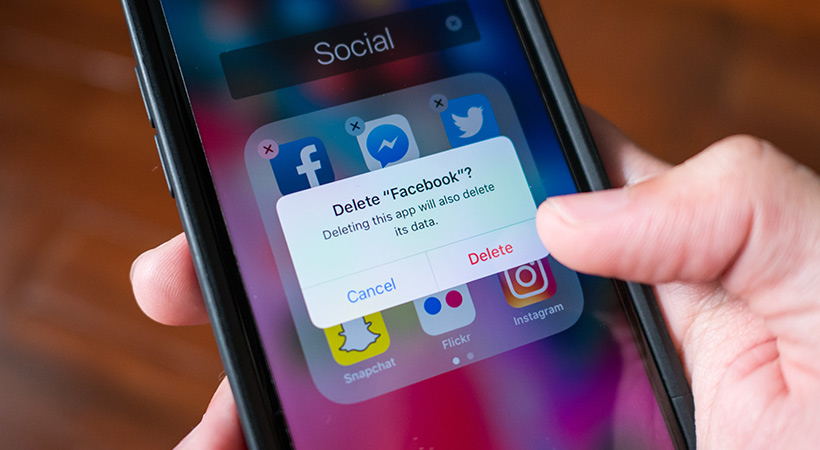Do you spend more time chatting to guys on apps than talking to your friends?
Does it sometimes feel like everyone — except you — is hot, successful and popular? And rich? And drowning in sex?
Is your screen time up 34% again this week?
Maybe it’s time for a digital detox.
According to research, gay and bisexual guys open their dating apps on average more than eight times a day. That’s over 90 minutes on average for every user, every day – and that’s before we even get into apps like Instagram (30 minutes a day), Facebook (38 minutes a day), Twitter (4 minutes per session) and YouTube (24 minutes a day).
Apart from being a massive time-suck, this sort of constant engagement with something usually hints at compulsive behaviour. Numerous studies also suggest that social media should be examined as a potential contributor – or even the outright cause – of depression, anxiety and addiction in frequent users. (Eight times a day = frequent use.)
A digital detox can help you stop the creep of bad digital habits into your work and social life. It can also bring a bit of balance back to your social media and dating app use, so you can enjoy it along with the rest of your life.

Set a timeframe for your detox
Set a start date and a timeframe for your detox. Be specific and tell someone else.
Make it achievable. A week or two is enough to give yourself a breather. If you’re looking to make lasting change, go for longer periods to help you establish good habits around your social media use.
Delete whatever isn’t adding something good to your life, and switch off notifications for the rest
While it’s not practical to blow up your online presence completely, take a hard look at which apps you really need.
Consider each app and ask yourself how you feel when you log off after a session. If it’s mostly making you feel rubbish, get rid of it. Be ruthless.
For everything else, customize or switch off your notifications in your notification preferences.
You can make use of the ‘do not disturb’ function on your phone to do this for specific periods of time, but be aware that it can also suppress important notifications like incoming calls and messages.
Let people know you’re doing a digital detox
You don’t need to make a general announcement, but let the important people know you’re going to be limiting your time online. Telling your friends you’re doing a digital detox can also help them support you in social situations, which often have a heavy online component. You may even inspire them to do a little detox of their own. And if that’s not encouraging enough, we’ll just leave this doco here.
The Social Dilemma | Official Trailer | Netflix
Work out when and why you use your apps the most
Understanding your own online habits is important if you want to change them. You can get a snapshot of your app use in your device’s settings – under ‘Screen Time’ for iOS, or ‘Digital Wellbeing’ for Android.
Take notice of which apps you’re using the most. Figure out when you’re using them and why. Do you look for distractions when you’re stressed at work? Does chatting to guys help when you’re feeling lonely? Do you post more when you’re feeling down?
Identify the itch they’re scratching for you. Once you understand the role your apps play in your life, plan your detox around meeting those needs in other ways.
Establish rules around your app use and stick to them
Put aside specific times of day you can check your apps, and set limits on how much time you spend online – say 10 minutes at 8.30am and then 20 minutes at 5.30pm. Set an alarm if that helps. You can also make use of your phone’s app timers (under ‘Settings – Screen Time’ for iOS, or ‘Settings – Digital Wellbeing’ for Android). App timers will shut down an app once you’ve used up your allocated time. This will help you avoid all those dead hours spent browsing your grid at midnight or going down the #instagays rabbit hole.
Make no-phone zones
Designate certain places as strict ‘no-phone zones’. It’s much easier to stay off apps when your phone isn’t in the room.
The bedroom is a good place to start. Using your phone just before bed has been shown to have a negative impact on sleep patterns, which in turn can be detrimental your mental health. The dinner table is another excellent place to keep phone free, especially if you’re eating with other people.
Have something you want to achieve during your time offline. Those 90+ minutes a day you’re getting back can definitely be put to use. It could be reading a book, exercising three times a week or mastering a new recipe. It could also be things like meeting friends for coffee/dinner/dancing once a week, or making time to visit family more often.
The point is to use the time in a way that brings new things you enjoy into your life, or new ways to spend time with people you care about. That way, when the detox is over, you’ll have other places to turn when you’re feeling bored, stressed, or lonely.

Check in on how you’re feeling, and expect some slip-ups
The aim of a digital detox is to help you feel better and bring a bit of perspective back to your app use. Make a point of checking in on yourself every few days to see what difference it’s making.
And go easy on yourself. Dating apps and social media are designed to keep you checking in — it’s how they make money. You’ll probably slip up once or twice just through force of habit.
Checking in with a professional
It’s OK if you’re processing challenging feelings from doing or thinking about a digital detox. Just know that help is at hand. You can now claim up to 10 visits to a mental health professional per year under Medicare. Talk to your doctor and set up a mental health plan or contact your local LGBTI health organisation for details of professional support services.